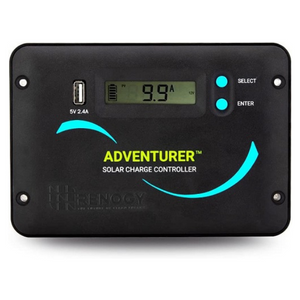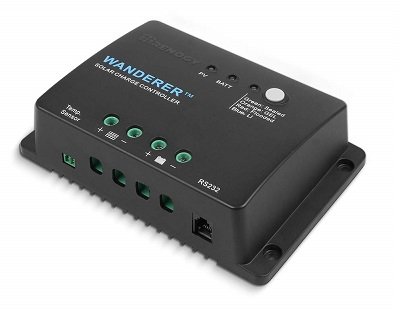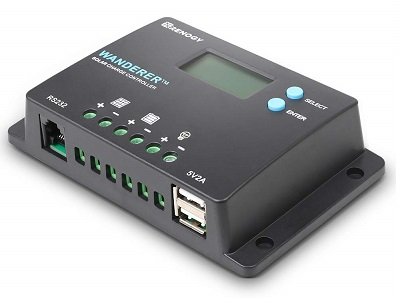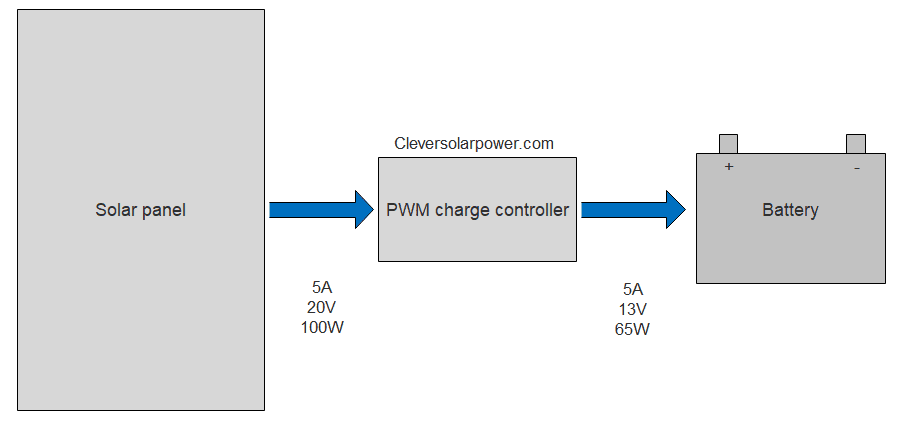You are here to find the best PWM solar charge controller.
Since you have chosen a PWM controller, I’m assuming you are looking for these characteristics:
- Cheap
- Cost-effective
- Easy to configure
- Compatible with lithium (LiFePO4) batteries
| Best Overall | Runner-up | Best Budget |
 |
 |
 |
| Renogy Wanderer |
Renogy Adventurer |
Renogy Wanderer |
| Best overall PWM charge controller for 12V battery and lots of solar power | Best PWM charge controller if you have a 24V battery and lots of solar power | Best value-for-money controller if you have a small number of solar panels |
| 12V Battery | 12/24V Battery | 12/24V Battery |
| 30A Charging current | 30A Charging current | 10A Charging current |
| 400W of solar | 390 (12V) / 780W (24V) of solar | 130 (12V) / 260W (24V) of solar |
Let’s look at each charge controller in detail
Best PWM Solar Charge Controller
Renogy Wanderer 12V 30A

We will start off the list with an old contender. The Renogy Wanderer 30A is the first that comes to mind when people ask me for a solid PWM charge controller. Most cheap PWM charge controllers aren’t compatible with lithium (LiFePO4) batteries, but this one is.
specifications:
- Max PV input voltage: 25V DC
- Max PV input power: 400W
- Charge current: 30A
- Compatible with: sealed lead acid, gel, flooded lead-acid and lithium (LiFePO4)
- Optional Bluetooth module for remote viewing
- Optional temperature sensor
Renogy Adventurer 12/24V 30A

If you need a PWM charge controller with a lot of solar panels and a 24V battery, I recommend getting this one. This is a charge controller which can take the most amount of solar panels on its input in this list.
- Auto detects 12 or 24V battery
- Max PV input voltage: 15-55V DC
- Max PV input power: 390W (12V); 780W (24V)
- Charge current: 30A
- Compatible with: sealed lead acid, gel, flooded lead-acid and lithium (LiFePO4)
- Optional Bluetooth module for remote viewing
- Optional temperature sensor
- 1x 5V 2.4A USB port
- No DC load output
Renogy Wanderer 12/24V 10A

If you need a charge controller compatible with either 12V or 24V, and you don’t have many solar panels, then this PWM charge controller is for you.
- Auto detects 12 or 24V battery
- Max PV input voltage: 15-55V DC
- Max PV input power: 130W (12V); 260W (24V)
- Charge current: 10A
- Compatible with: sealed lead acid, gel, flooded lead-acid and lithium (LiFePO4)
- Optional Bluetooth module for remote viewing
- Optional temperature sensor
- 2x 5V 2A USB ports
Renogy Voyager 12/24V 10-20A

This PWM charge controller’s main selling point is that it is waterproof. This will be ideal for marine environments.
If you don’t expect it to get wet, you can still use the Renogy Wanderer 12/24V 30A.
- Waterproof
- Auto detects 12 or 24V battery
- Max PV input voltage: 15-55V DC
- Max PV input power: 260W (12V); 520W (24V)
- Charge current: 20A
- Compatible with: sealed lead acid, gel, flooded lead-acid and lithium (LiFePO4)
Buying Guide for PWM Charge Controller
First, we need to ensure you understand the PWM charge controller requirements. These are:
- Battery voltage
- Charging current
- Solar panel voltage
Battery voltage
Most PWM charge controllers are made for a 12V or 24V battery. The PWM charge controller will detect the voltage of the battery automatically. Not all PWM charge controllers are compatible with a 24V battery. I suggest not using a PWM charge controller if you have a 48V battery. I don’t even think they exist.
If your battery voltage is 24V, you can use double the solar input than if you were to use a 12V battery. Let’s show this with an example.
12V * 30A charge controller = 360W of solar
24V * 30A charge controller = 720W of solar
As you can see, if you use a 12V battery, you can use 360W of solar with a 30A charge controller.
If you use a 24V battery, you can use double the number of solar panels.
Charging Current
The current shown on a PWM controller is the charging current from the solar panels to the batteries.
This means that if we have a 30A charge controller, we can have:
30A * 12V = 360W of solar
This is not to be confused with the current from the solar panels.
Solar panel voltage
There will be a maximum amount of voltage listed as the input of the charge controller. This is usually 50VDC.
In the following diagram, you can see how a PWM charge controller works.
A 20V, 5A solar panel is connected to a PWM charge controller. The PWM charge controller cuts the voltage down to the charging voltage of 13V. Because this is a PWM charge controller, the current is not increased but stays the same. That’s why you have a 30% efficiency loss.
Therefore it is important to have your panels match the battery voltage. Do not use a 50V panel on a 12V battery because you will lose a lot of power.
50V * 3A = 150W
13V * 3A = 39W
You will reduce your 150W panel to only 39W because your voltage doesn’t match the battery voltage. That’s a loss of 74%!
Connect your solar panels in parallel if you use a PWM controller.

Conclusion

If you have a 12V system and many solar panels, this is the best value for money.
Read more:
PWM charge controller efficiency
How many watts can a PWM charge controller handle?

I’m an off-grid enthusiast. I created this website to give clear and straight-to-the-point advice about solar power. I’m also the author of the book ‘Off-grid solar power simplified‘. Read more about me on my about page, check out my Youtube channel, or send me a message.